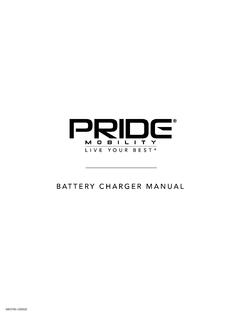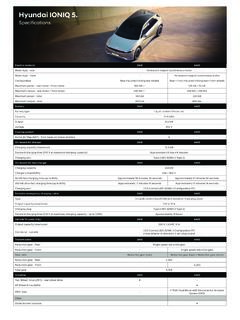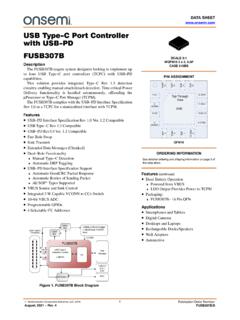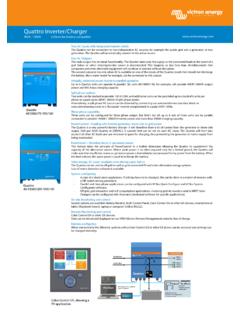Transcription of Electrical and Electronics Technical Team Roadmap - Energy
1 I Electrical and Electronics Technical Team Roadmap Roadmap October 2017 Electrical and Electronics Tech Team Roadmap ii This Roadmap is a document of the DRIVE Partnership. DRIVE (Driving Research and Innovation for Vehicle efficiency and Energy sustainability) is a voluntary, non-binding, and non-legal partnership among the Department of Energy ; USCAR, representing FCA US LLC, Ford Motor Company, and General Motors; five Energy companies BP America, Chevron Corporation, Phillips 66 Company, ExxonMobil Corporation, and Shell Oil Products US; two utilities Southern California Edison and DTE Energy ; and the Electric Power Research Institute (EPRI). Electrical and Electronics Tech Team is one of 13 DRIVE Technical teams that work to accelerate the development of pre-competitive and innovative technologies to enable a full range of efficient and clean advanced light-duty vehicles, as well as related Energy infrastructure.
2 For more information about DRIVE, please see the DRIVE Partnership Plan, at or Electrical and Electronics Tech Team Roadmap iii Executive Summary Electric traction drive systems (ETDS) have experienced significant changes over the past 20 years. Battery electric vehicles with a range of 200 to 300 miles are available today with equivalent or better performance than comparable internal combustion engine (ICE) vehicles. Electric vehicle charging (refueling) at home has become a feature highly valued by consumers, and fast -charging capability brings the promise of refueling times comparable to ICE vehicles. In the last 2 years this drastic improvement in vehicle electrification has coincided with a radical transformation of society s understanding of mobility. Historically, personal vehicles have opened the door to freedom-of-movement and self-expression, but now transportation is available as a service (oftentimes called mobility-as-a-service, or MaaS).
3 These changes improved electrification and transformed mobility drive the four fundamental trends impacting the Electrical and Electronics Technical Team (EETT): 1. Adoption of electrified skateboard chassis that includes both the electric traction drive system and Energy storage. This provides greater vehicle design freedom, more usable passenger space, and a modular platform to increase production scale. 2. MaaS trades the traditional ownership model driven by personal taste for a fleet ownership model driven by lifecycle cost. This drives on-board power and electromagnetic interference requirements, autonomous and extreme fast charging, and the need to maximize usable space on the vehicle. 3. Production scale needed for mass market viability has moved from 100,000 to 500,000 units per platform. This has been driven by intense competition in the auto industry.
4 4. Vehicle performance requirements are driving demand for higher-power ETDS. Consumers want significantly faster acceleration and larger, more versatile vehicles. These trends require that ETDS design evolves rapidly to achieve and maintain commercial success. The systems must fit in a skateboard chassis requiring nearly an order of magnitude (8x) increase in power density, have twice the reliability (300,000 miles), and be modular and scalable for use on vehicle platform variants, all while producing higher power. Achieving this will require heterogeneous or multi-physics integration of materials, nano-carbon infused metals, a new class of isolation materials, high -temperature materials, and new thermal management techniques. Additionally, there is a need to understand and quantify the physics of materials and their interactions under extreme power and temperature.
5 This document describes the research and development necessary to achieve the future vision of Energy -efficient transportation which is vital for both increased personal mobility and continued economic growth. Electrical and Electronics Tech Team Roadmap iv This Roadmap was developed collaboratively through an iterative process to ensure it represents a united vision of industry and government stakeholders. The EETT OEM partners were actively involved in the 2025 target development process. Technology gaps and strategy to achieve the targets are based on OEM and supplier input . Industry engagement took the form of a face-to-face multi-day meeting and individual company follow up throughout the course of Roadmap development. As a result, the Roadmap includes two specific Technical guidance documents, one for power Electronics and one for electric motors (included in the appendix), which were driven by the OEMs and confirmed by the suppliers.
6 The gap between current technology and the 2025 Technical targets defines the need for new technologies, material advancements and new manufacturing processes. OEM, supplier, and national laboratory engagement were instrumental in developing the strategy for this Roadmap . The chosen strategy to overcome current barriers and achieve the Technical targets is to conduct R&D with industry input aimed at achieving a significant technology push. DOE national laboratories are working with the supply base to improve wide bandgap-based power Electronics and non-rare earth or magnet-less electric motors to meet the 2025 ETDS R&D targets. Component targets and material requirements were identified and reviewed with suppliers. Supplier-based solutions were encouraged as the national laboratories focus on early-stage research to close the Technical gaps in knowledge and on conducting system and component tradeoffs (see Figure ES-1).
7 This will result in basic technology building blocks to be used as inputs for automotive OEM advanced development groups. The OEMs will provide guidance by reviewing requirement development and conducting design reviews. Program status is evaluated in relation to the Technical targets on an annual basis. Figure ES-1. Automotive Product Development Cycle Electrical and Electronics Tech Team Roadmap v Table of Contents Executive Summary .. iii Acronyms .. viii Team Mission and Scope ..1 Mission .. 1 Scope .. 1 Key Challenges to Technology Commercialization and/or Market Penetration ..4 Market Status .. 4 Key Challenges: Cost and Size .. 5 Future Trends .. 6 Technical Targets & Status ..8 Target Definition .. 8 Electric Traction Drive System Targets .. 9 high -Voltage Power Electronics Technical Targets .. 9 Electric Traction Motor Technical Targets.
8 10 DC/DC Converter Technical Targets .. 10 On-Board charger Technical Targets .. 11 Current Technical Target Status .. 12 Gaps and Barriers to Reach 2025 Technical Targets .. 14 Power Electronics .. 15 Electric Motors .. 15 Strategy to Overcome Barriers and Achieve Technical Targets .. 17 Power Electronics Strategy .. 17 Power Electronics R&D Areas .. 18 Multi Physics Integration .. 19 Thermal Strategy .. 19 Power Module .. 20 Passives .. 20 In-Board Devices .. 21 Chip Set Integration .. 21 Electric Motors 22 Electric Motor R&D Areas .. 24 Material Physics Based Models .. 24 Base Materials .. 25 Non-Rare-Earth Magnets .. 25 Conductive Material .. 25 high Voltage Insulators .. 25 Thermally Conductive Epoxy, Fillers, and Winding Insulation .. 26 Electrical and Electronics Tech Team Roadmap vi Appendix A Wide Bandgap Advanced Integrated Power Module 2025 Technical Guidelines.
9 A-1 Appendix B Non-Heavy Rare Earth Advanced Electric Motor Design 2025 Technical Guideline .. B-1 Appendix C ORNL Testing and Evaluation Data on 2016 BMW i3 .. C-1 Electrical and Electronics Tech Team Roadmap vii Table of Figures Figure ES-1. Automotive Product Development Cycle .. iv Figure 1. Components of Generic ETDS .. 2 Figure 2. EDV Architecture Layouts .. 3 Figure 3. Light Duty Electric Drive Vehicles Monthly Sales Updates .. 4 Figure 4. Average Combined ETDS Peak Power for HEVs and PEVs 2010-2016 (bubble size represents relative annual sales and 2009 includes data from prior years. 2017 data through September.. 5 Figure 5. Projected EDV Sales .. 6 Figure 6. 2017 Chevrolet Bolt BEV Chassis with Powertrain (left); Example of a Flat Skateboard Chassis Containing Electric Powertrain (right).. 7 Figure 7. high Voltage Power Electronics Cost Status (2015 EETT target).)
10 13 Figure 8. Electric Motor Cost Status (2015 EETT target) .. 14 Figure 9. Rare Earth Metal Prices Track Oxides Very Closely .. 16 Figure 10. Inverter Cost Breakdown for a Potential Pathway to Meeting 2025 Target .. 18 Figure 11. Power Electronics R&D Areas .. 19 Figure 12. Electric Motor Types .. 22 Figure 13. Electric Motor Cost Breakdown for a Potential Pathway to Meeting 2025 Target .. 23 Figure 14. Electric Motor R&D Areas .. 24 Figure C-1. 2016 BMW i3 Inverter Assembly Including 12V DC/DC Converter and AC/DC charger .. C-1 Figure C-2. 2016 BMW i3 Electric Motor (External View [top right and left], Rotor [bottom left], and Stator with Cooling Channels [bottom right].. C-3 Figure C-3. 2016 BMW i3 Electric Motor (top), Inverter (middle) and Combined System (bottom) Operating Efficiency Maps.. C-4 List of Tables Table 1. Key EDV Architecture 3 Table 2.)

















